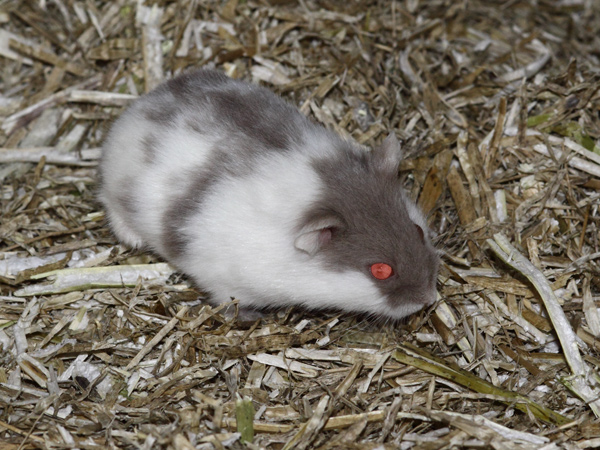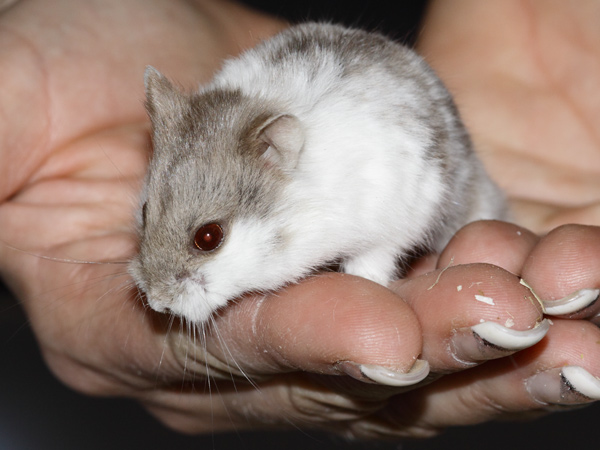vrijdag, 16 december, 2011, 3:15 pm
door Martin Braak
Het volgende stuk staat op www.RatBehavior.org:door Martin Braak
In the embryo, a fold develops down the back called the neural tube, which contains an active region called the neural crest. This region supplies the pigment cells (melanocytes) that migrate all over the body.
Specifically, the pigment cells migrate to pairs of specific sites on either side of the body as well as the backline. There are three such sites on the head (near the eye, near the ear, and near the top of the head), and six sites along each side of the body, and several along the tail. A few pigment cells migrate to each of these sites, where they proliferate and migrate outwards, joining up to form larger patches, spreading down the legs and down the head until they meet up under the chin, and down the body until they meet up on the belly (Cattanach 1999).
Once the pigment cells have finished migrating they take up positions at the base of hair follicles. There they synthesize melanin pigment, and feed it into the growing hair. Normally, all follicles have pigment cells associated with them and all the animal's fur is pigmented. But if no pigment cells are associated with a follicle, there is no pigment in that hair. Mutations that affect pigment cell distribution during the development of the embryo determine which parts of the body have pigment cells, and hence produce pigment, and which parts have no pigment cells and produce depigmented hairs.
Pigment cells also migrate to the iris and retina of the eye. If the iris does not have pigment cells, it looks red (in rats and mice) or blue (dogs and cats). Odd-eyed rats are caused by the migration of pigment cells to one eye but not the other. (Note: the white coat and red eyes of albinos are not caused by a failure of pigment cell migration, but by the inability of pigment cells to produce pigment).
Pigment cells migrate to the inner ear too (cochlea and stria vascularis), where they play an undefined but essential role in maintaining hearing. If the inner ear does not have pigment cells, the individual may be deaf.
Pigment cells also migrate to the brain, to areas such as the substantia nigra (part of the midbrain that regulates mood, produces dopamine, and controls voluntary movement), the locus ceruleus (part of the brain that deals with the stress response) as well as other areas such as the leptomeninges (membranes surrounding the brain), the dorsal root ganglia, and the cranial ganglia. The failure of pigment cells to reach these areas can have a wide variety of effects, such as a movement disorder (e.g. seizures), and diverse effects on behavior and the individual's response to stress.
Pigment cells are therefore implicated in areas of the brain related to mood and the stress response. This connection between depigmentation and behavior probably played a role in animal domestication. By selecting for tameness, breeders selected for a different pigment cell migration in the developing nervous system, leading to calmer animals. A side effect of this selection for behavior was the change in pigment cell migration in the skin, leading to a piebald coat. Piebaldness and associated docility are found in many different domesticated species (horses, cows, dogs, cats, birds). In fact, selection of wild animals for tame behavior leads to depigmented areas on the fur, as shown in foxes (Belyaev 1979, Trut 1999) and rats (Trut et al. 1997). Note, however, that if depigmentation is extreme, the animal may have neurological impairments (Grandin 1998). Here's more on coat color, temperament and domestication.
Pigment cells aren't the only cells that migrate from the neural crest. Neural cells that enervate the intestines make the migration too. If the necessary neural cells don't reach the end of the intestine, the animal's intestines may not fuction properly, rendering the animal unable to pass feces, which results in megacolon.
There are many mutations that may affect the migration of cells from the neural crest. Each mutation is different, each may be modified by other genes. Each mutation may have a constellation of effects (pleiotropic effects) on coat color, behavior, and sensory function. This is why white coloration, eye color anomalies, deafness, and megacolon are often found together. They are all the result of a delay in cell migration from the neural crest.
Heel kort samengevat waar het me nu even om gaat: pigmentcellen zijn eveneens aanwezig op delen van de hersenen. Een bontfactor, daarvan zeg ik altijd dat kan ook in de hersenen voorkomen. Meeste mensen begrijpen niet wat ik hiermee bedoel. Feitelijk staat hierboven waarom en hoe. Bij bont ontbreekt pigmentvorming. Bij de hersenen speelt pigment eveneens effect. En het ontbreken hiervan kan zorgen voor karakter afwijkingen en stress aanvallen. Hoe witter de kop bij de bontfactor is, hoe meer risico.


Pas hiermee erg op!
Link: http://www.ratbehavior.org/CoatColorMutations.htm